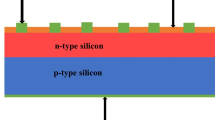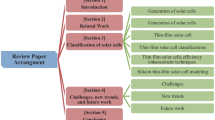Abstract
The electromagnetic property of graphene is studied by finite-difference time-domain (FDTD) method. As the graphene has excellent electrical conductivity and high transparency, it has certain advantages as a transparent electrode for solar cells. This paper designs a three-layer film structure composed of graphene, silicon, and silicon dioxide (SiO2). Then, the effects of the chemical potential and the scattering rate of the graphene on the light absorption of the film are studied. The study found that the electromagnetic property of graphene is relatively stable, which is not easily influenced by the external environment. After changing its chemical potential, scattering rate, and other parameters, it is found that the film absorption rate is less affected unless the large range of chemical potential changes; it will lead to a decline in the absorption rate of light.








Similar content being viewed by others
References
Vakil A, Engheta N (2011) Transformation optics using graphene. Science 332(6035):1291–1294
Suk JW, Kitt A, Magnuson CW, Hao Y, Ahmed S, An J, Swan AK, Goldberg BB, Ruoff RS (2011) Transfer of CVD-grown monolayer graphene onto arbitrary substrates. ACS Nano 5(9):6916–6924
Bouzianas GD, Kantartzis NV, Tsiboukis TD (2012) Subcell dispersive finite-difference time-domain schemes for infinite graphene-based structures. IET Microwaves, Antennas & Propagation 6(4):377–386
Di Xu, Cheng Deng, Hai Lin, Helin Yang (2013) A versatile material model for the FDTD simulation of graphene,” IEEE International Conference on Microwave Technology & Computational Electromagnetics, Qingdao, p 345–348
de Oliveira RMS, Rodrigues NRNM, Dmitriev V (2015) FDTD formulation for graphene modeling based on piecewise linear recursive convolution and thin material sheets techniques. IEEE Antennas and Wireless Propagation Letters 14:767–770
Wang S-Y, Zhang T, Yin W-Y, Zhou L (2013) Interaction of electromagnetic waves with multilayer bi-anisotropic graphene structure. Radio Science Meeting. IEEE, Lake Buena Vista, p 53–53. https://doi.org/10.1109/USNC-URSI.2013.6715359
Wang X-C, Zhao W-S, Hu J, Zhang T (2013) A novel tunable antenna at THz frequencies using graphene-based artificial magnetic conductor (AMC). Progress in Electromagnetics Research Letters 41:29–38
Yang L, Li L, Chen L (2015) Electromagnetic characteristics of 1D grapheme photonic crystal by using SBC-FDTD method of oblique incidence in THz. Progress in Electromagnetics Research M 43:135–145
Lixia Y, Lingling L, Ting Z, Lijuan S (2016) Terahertz electromagnetic characteristics of one-dimensional graphene-photonic crystal by FDTD method (in Chinese). Chinese Journal of Radio Science 31(2):262–268
Liu Y-J, Xie X, Xie L, Yang Z-K, Yang H-W (2016) Dual-band absorption characteristics of one-dimensional photonic crystal with graphene-based defect. Optik 127(9):3945–3948
Guo-long L, Jing-ming Z, Li-hui W, Jin L, Li-jun H (2015) Antireflection coatings in graphene-based polymer solar cell (in Chinese). Advances in New and Renewable Energy 3(5):336–339
De-biao G, Yue-li W, Xiang-qin Z (2003) Shift operator method applied for dispersive medium in FDTD analysis (in Chinese). Chinese Journal of Radio Science 18(4):359–363
Yang H-W, Ru-Shan C, Yun Z (2006) SO-FDTD method and its application to the calculation of electromagnetic wave reflection coefficients of plasma (in Chinese). Acta Phys Sin 55(7):3464–3469
Hong-wei Y, Hong Y, Ru-shan C, Yang Y (2007) SO-FDTD analysis of anisotropic magnetized plasma (in Chinese). Acta Phys Sin 56(3):1443–1446
Yang HW, Liu Y (2013) SO-FDTD analysis on the stealth effect of magnetized plasma with Epstein distribution. Optik 124(15):2037–2040
Hong-wei Y, Ru-shan C, Yun Z (2006) SO-FDTD method and its application to the calculation of electromagnetic wave reflection coefficients of plasma (in Chinese). Acta Phys Sin 55(7):3464–3469
Liu J-x, Zhang L-x, Zhang J-l, Yang Z-K, Yang H-W (2016) Anisotropic ferrite microstrip antenna simulation and analysis. Optik 127(8):4144–4149
Yin X, Zhang H, Zhao Z-W, Sun SJ (2012) A high efficient SO-FDTD method for magnetized collisional plasma. Journal of Electromagnetic Waves and Applications 26(14–15):1911–1921
Zhou F, Hao R, Jin X-F, Zhang X-M, Li E-P (2014) A graphene-enhanced fiber-optic phase modulator with large linear dynamic range. IEEE Photon Technol Lett 26(18):1867–1870
Guo Y, Zhang T, Yin W-Y, Wang X-H (2017) Improved hybrid FDTD method for studying tunable graphene frequency-selective surfaces (GFSS) for THz-wave applications. IEEE Transactions on Terahertz Science and Technology 5(3):358–367
Xie Yanan, Liu Zhikun, Geng Li, Pan Dengke, Song Pan,“Properties of graphene and antenna applications in microwave to THz,” Acta Opt Sin, 35, S116005–S116007, 2015
Rubin M (1985) Optical properties of soda lime silica glasses. Sol Energy Mater 12(4):275–288
Green MA (2008) Self-consistent optical parameters of intrinsic silicon at 300K including temperature coefficients. Sol Energy Mater Sol Cells 92(11):1305–1310
Aksoy S (2007) An alternative algorithm for both narrowband and wideband Lorentzian dispersive materials modeling in the finite-difference time-domain method. IEEE Transactions on Microwave Theory and Techniques 55(4):703–708
Koledintseva MY, Drewniak JL, Pommerenke DJ, Antonini G, Orlandi A, Rozanov KN (2005) Wide-band Lorentzian media in the FDTD algorithm. IEEE Trans Electromagn Compat 47(2):392–399
Shibayama J, Sasaki N, Wakabayashi Y, Yamauchi J, Nakano H (2013) Frequency-dependent fundamental LOD-FDTD formulation for a multipole Debye model. IEEE Photon Technol Lett 25(10):965–968
Zhu R-J, Wang J, Jin G-F (2005) Mie scattering calculation by FDTD employing a modified Debye model for gold material. Optik 116(9):419–422
Funding
This work is supported by the excellent project of Nanjing Agricultural University (Grant No. JF17080123) and the College of Sciences of Nanjing Agricultural University (Grant No. CoS201410).
Author information
Authors and Affiliations
Corresponding author
Rights and permissions
About this article
Cite this article
Liu, JX., Xie, X., Du, P. et al. Effect of Graphene on the Sunlight Absorption Rate of Silicon Thin Film Solar Cells. Plasmonics 14, 353–357 (2019). https://doi.org/10.1007/s11468-018-0811-6
Received:
Accepted:
Published:
Issue Date:
DOI: https://doi.org/10.1007/s11468-018-0811-6




